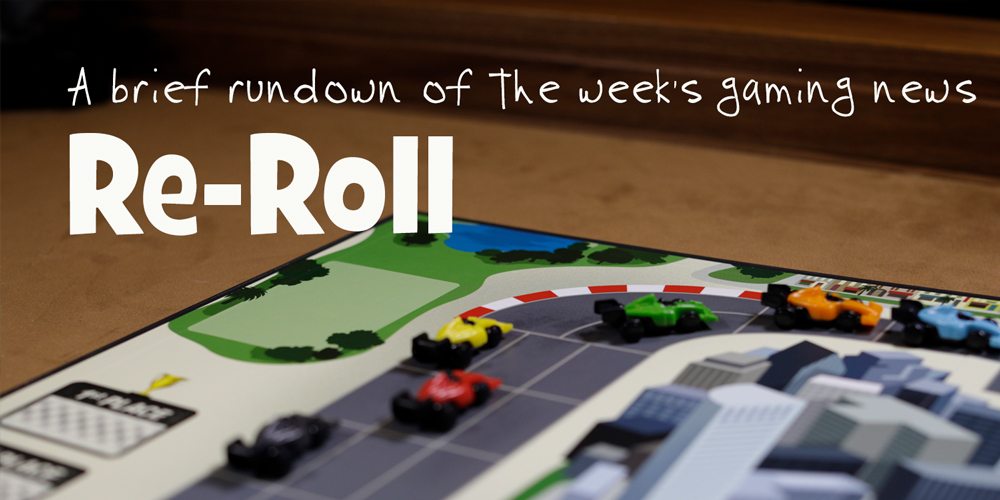
Prowler’s Passage, the newest offering from publisher Renegade Games and designer J. Alex Kevern (who designed last year’s Sentient for the same company) is, if you believe what you read on the box, a game about two rival thieves plundering a vast city, racing to become the “premier prowler.”
I’m not sure that story holds up to much scrutiny (the more you steal, the more influence you have in your city, which makes me wonder if this is some sort of kleptomaniac-worshiping society), but the good news is, that doesn’t really matter at all.
Prowler’s Passage, for 2 players, is a glittering, jagged edged diamond of a game. It plays in roughly 25 minutes and is listed for players age 12 and up. And, spoiler alert, it’s good. Really, really good. So buckle your belt, pull down your hood, and walk softly: we’re heading into Prowler’s Passage…
What Comes in the Box?
In a day and age where it seems like each publisher is trying to outdo the last in terms of gargantuan boxes packed to the gills with “stuff,” the trim, medium-to-small box for Prowler’s Passage is a breath of fresh air. It won’t gobble up shelf space but is big enough and pretty enough to catch your eye. Opening it, you will find the following:
- 1 Control track
- 10 Board hexes
- 27 Object tiles (double-sided)
- 5 District control markers
- 4 Statues
- 15 Achievement cards
- 26 Passage sections
- 2 Scoring reference cards
- 1 Scorepad w/ pencil
Everything in Prowler’s Passage is solid, with strong cardboard components and dark, mysterious artwork that does a lot towards building the world. Unfortunately, that artwork also serves as the one big flaw in an otherwise excellent game.

Each city hex is divided into districts, of which there are 5. Each district is represented by a different color (pink, white, yellow, blue, and brown). Unfortunately, the combination of detail on the artwork and somewhat subtle color palette lead to a game where even I struggle to tell the difference between city districts at times, repeatedly misidentifying white for yellow or visa versa. I can only imagine that it would be nearly impossible to play for any with mild to severe color blindness.
That’s a surprising, but admittedly small, issue and one which could be easily fixed in future printings. And, apart from that, the game is beautiful, compact, and intriguing.
Prowler’s Passage is GeekDad Approved!
How to Play Prowler’s Passage
The goal of Prowler’s Passage is to score the most points, and while there are many ways to score, there’s very little to the actual gameplay (which seems to be a hallmark of Kevern designs–simple moves with complex ramifications).
Setup
First, the control track is laid out and six random city tiles are drawn and arranged to form a pyramid of sorts, making sure the corners are properly aligned (there are clear markings to make sure everything is angled properly). The five district control markers are placed in the center of the control track. 4 statues are placed on the board at the central most intersections of the city. 3 achievement cards are randomly drawn and placed around the control track. Object tiles are then randomly (without paying attention to which face is up or how they’re organized in the city) placed on each of the internal roads (so never on roads that make up the edge of the playing area). And finally each player receives a scoring reminder card and 13 wooden passages in their color (either green or pink).

Playing
On their turn, each player has only one choice to make, and that’s where in the city they want to place one of their passages. This passage will be placed on an unclaimed road. This, however, results in a few effects.
- They will take whatever item token was on that road and add it to their stash.
- They will look at the districts that border the road on either side and will move the influence markers for those districts one space towards them on the control track (or, if the same district is on both sides, then that control marker will be moved twice).
- If the object they claimed was a gold shovel, they will immediately move any district marker of their choice one space towards them on the control track.
- If the object was a double shovel, then they will double the district movements taken that turn based on their passage border.
- If their passage caused a statue to be completely surrounded by passages, then they also take that statue and add it to their stash.
- If any of the above causes them to meet the requirements of an achievement card, they add that card to their stash.
Play proceeds in this fashion until one of two events triggers mid-game scoring. Either two of the four statues have been claimed, or both players have only 5 passages remaining. After mid-game scoring, the game proceeds on in the same fashion until all passages have been played, then final scoring happens, both scores are added together, and the player with the highest score wins.

Scoring
Earning points, especially trying to do so efficiently, is far and away the most difficult part of Prowler’s Passage. Apart from achievement cards (which only count towards your final score) all scoring is calculated the same way both at mid-game and end-game. Let’s walk through each other factor that will score you points.
- Roads: For your longest, connected road you will earn 2 points per passage in it. So a passage that’s 3 units long will earn you 6 points. Your passage can cross itself, but cannot double back on itself.
- Statues: Each statue you have is worth 1 point.
- Treasure: As you lay your passages, you’ll be collecting loot from those spaces (or, sometimes, shovels). The four different kinds of loot are gold, keys, jewels, and books. The more of each type you collect, the more their value increases exponentially. A single gold token is worth a single point, 2 gold tokens are worth 3 points, and so forth to the point where, should you manage to collect 7 of a single type of token, it will earn you a whopping 28 points. You will score in this fashion for each of the four types of loot.
Note: The following five scoring systems each correspond to one of the five districts. At both mid-game and end-game scoring, only the player who has the most influence (I.E. has the control marker for that district on their side of the control track) over a district will score for it.
- Banking District (yellow): 1 extra point for each gold token you possess, plus 5 bonus points.
- Political District (blue): 1 extra point for each book token you possess, plus 2 points for each district you currently control.
- Market District (purple): 1 extra point for each jewels token you possess, plus an extra point for each statue and achievement card you have, plus points equal to the distance the market district control marker is from the center of the track (so the farther you advance it towards you, the more points it’s worth).
- Residential District (brown): 1 extra point for each key token you possess, plus points equal to the length of your longest passage minus 2 (so if your passage is 7 units long, you earn 5 bonus points).
- Castle District (white): Lose 1 point for each shovel token you possess, then divide all your non-shovel tokens into as many matching pairs as possible and gain 3 points for each pair.
Achievement cards can be earned based on a variety of parameters, and state the points they are worth right on the card. These are added in during the final scoring phase, just before both scoring phases are added together.

Will You Like Prowler’s Passage?
This game is uniquely brilliant, which is precisely the reaction I had to Kevern’s game Sentient last year, only this game takes it to new heights. Kevern seems obsessed with the idea of freezing you in your tracks with seemingly simple decisions. As you sit down to play your first game, you may find yourself wondering how this game will possibly hold your interest. You play a passage, take your loot, and move on. Pretty simple. It isn’t until you find yourself losing by 30 points at mid-game scoring with zero clue what you did wrong that you sit up a little straighter, narrow your gaze, and start to understand.
Only “understand” is a strong word, because Kevern has created such a baffling, inter-connecting web of scoring options that if you try to fully wrap your head around it you’ll quickly realize that whole seasons are passing by between turns as you sit and stare . At first, this may feel decidedly uncomfortable, especially if you’re like me and prefer games that you can comprehend quickly and then take your time to excel at. But Prowler’s isn’t about complete understanding, it’s about knowing enough to know what you don’t know. And if that sounds confusing, that’s because, at first, it is.

If you want to make the “right” move, then you’ll never be able to take a turn in Prowler’s Passage. Instead, you have to boldly stride ahead into the dark alleyways of the city, confident that you can make a move that’s “right enough.” You will never beat J. Alex Kevern, who is embodied in the meticulous systems of his game, and the sooner you discard that notion the better. Instead, you have to constantly remind yourself that you only goal is to beat the person sitting across from you, and them remember that they can’t possibly understand this game that much more than you. It’s like the old joke:
Eric and Brittany are sitting at their campsite when they hear a bear crashing through the woods towards them. Eric is leaps to his feet and then stops, seeing Brittany stooping to tighten the laces on her shoes. “You know you can’t outrun a bear, right?” Eric says, incredulously. “I know that,” Brittany nods, straightening up, “But I don’t have to. I just have you outrun you.”
This game is the bear and you’ll never outrun it. The sooner you realize that, the sooner you’ll start racing your opponent instead, and that’s when things get really good.

Every move you make, you must take into account what you’re gaining, and what the other player is losing. Do they have a district that will score them a lot of points? Maybe you need to focus on stealing control of that district even though it won’t gain you many points. Are they close to joining two passages to make one giant passage? Maybe you need to sneak in and block their path. Sometimes is feels like Prowler’s Passage is one giant illustration of a zero-sum game, and the leverage to be had is subtle and hard-earned. All your machinations and efforts may result in a contested district ending where it began, right in the middle of the control track where neither player will score it. However, depending on how much your opponent stood to gain from it, that may well count as a win for you.
As always, I encourage you to research the game as much as possible before deciding if it’s for you, but I suspect this will have a very broad appeal. More casual gamers can happily pick it up, as it’s easily learned and taught, while those who prefer heavier fare will find a puzzle more than equal to their challenge wrapped up this compact and appealing package. And, at an MSRP of $34.99, this is an enormous amount of bang for your buck. So as you sit down to your first play, I just encourage you to remember: you don’t have to outrun the bear.

Click here to see all our tabletop game reviews.
If you’d like to stay up-to-date with all of our tabletop gaming coverage, please copy this link and add it to your RSS reader.
Disclosure: GeekDad received a copy of this game for review purposes.






